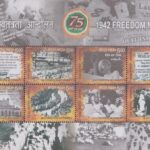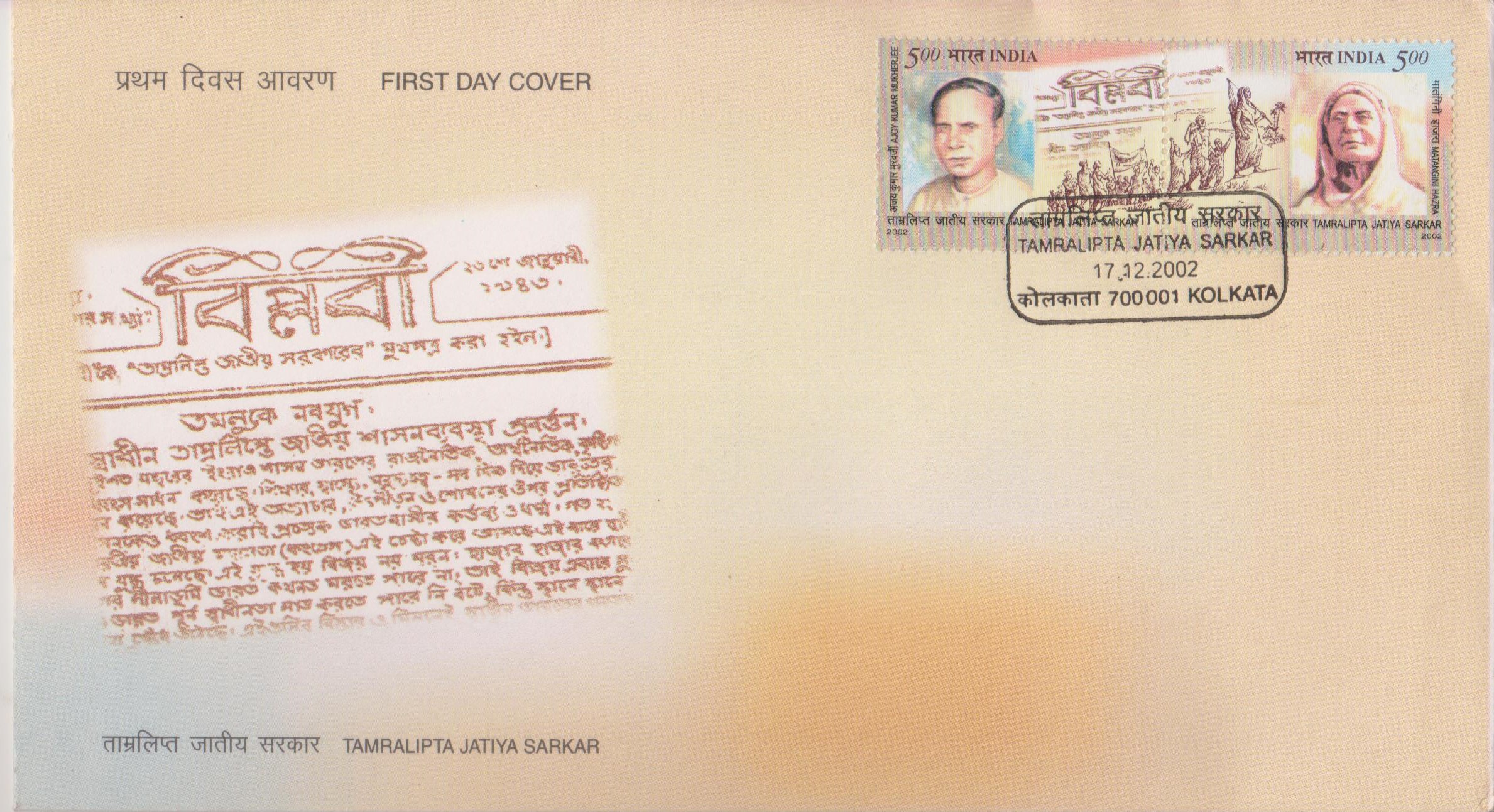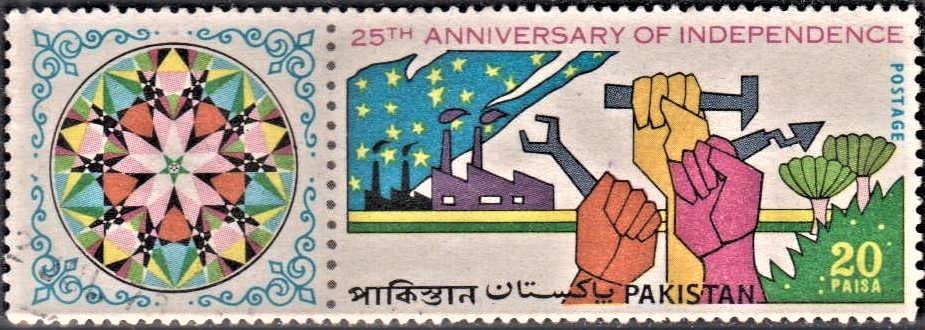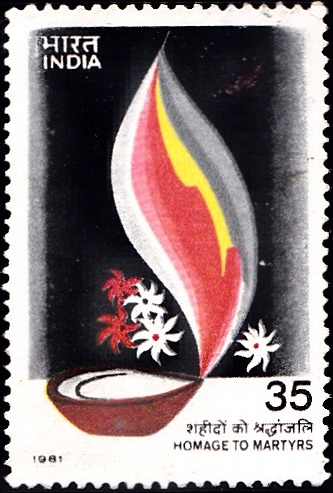
Indian Homage to Martyrs 1998
Complete Set of 2 nos of postage stamps on the 50th Anniversary of the Independence of India :



 Issued by India
Issued by India
Issued on Aug 15, 1998
Issued for : At the conclusion of the 50th anniversary of Independence, the Department of Posts pay homage to the martyrs of the freedom struggle with the issue of this special / commemorative setenant of two stamps, symbolising the years of struggle for Independence, the attainment of independence and India’s achievements in the post-independence years.
Design : The instant stamp design portrays progressively from left to right our struggle for freedom culminating in the demand for self-government and eventual independence, leading on to industrial, scientific and technological developments – all contributing to the building of modern India. The spirit of adventure and exploration resulting in Indian scientists, especially geo-physicists and oceanographers reaching Antarctica is also suggestively proposed in the stamp design. The first day cover depicts the first slogan postmark, heralding the historic day, 15th August 1947 along with the first postage stamp issued, by Independent India.
Credits :
Stamp design : C. R. Pakrashi
FDC & Cancellation : Alka Sharma
Type : Se–tenant set of 2 Stamps, Mint Condition
Colour : Multi Colour
Denomination : 300 & 800 Paise
Overall size : 2.88 X 6.68 cms.
Printing size : 2.53 X 6.33 cms.
Perforation : 13 x 13
Paper : Imported un w/m Adhesive Gravure Coated stamp paper in Sheets 50.8 x 53.5 cms.
Stamps Printed : 0.7 Million
Number per issue sheet : 21/Setenant
Printing Process : Photogravure
Printer : India Security Press, Nashik
About :
- India’s emergence as an independent nation was the culmination of the largest mass movement spread across almost a century. The British rulers met with stiff resistance right from the beginning of their rule in India. The peasants, the tribal people, the chiefs and other sections rose up in revolt in every part of the country at different times. The year 1857 witnessed the first widespread armed uprising which shook the foundations of British rules in India. The British restored to brutal repression measures, to crush the uprising. Even after the great uprising of 1857 had been crushed, popular discontent against British rule, however, continued to manifest in armed revolts in different parts of the country during the remaining years of the 19th century.
- Side by side, new political forces emerged which gave rise to a nationwide movement for national liberation. As the First World War ended, the Indian National Movement entered the era of mass struggle against repression, for “Self-Rule”. A new element was ushered in into the political life of the country – the involvement of the common people in the struggle for freedom, with Mahatma Gandhi emerging as the greatest leader in India’s struggle for freedom.
- One of the worst political crimes of the 20th century was committed in Punjab during 1919. On 13th April, the day of Baisakhi festival, troops under Gen. Dyer opened fire without warning on a completely peaceful and defenceless crowd at the Jallianwala Bagh ground which was enclosed on all sides. The massacre stunned the people and became a turning point in the history of the struggle for freedom. With Gandhiji’s call for ‘Non-Cooperation’ peasant struggle intensified in U.P., Bihar, Rajasthan, Andhra and Bengal, becoming nationwide.
- The revolutionary movement of 20’s and 30’s which developed alongside was an integral part of the struggle for freedom. The revolutionaries, however, slowly gave up terrorist methods and concentrated on building mass organisations of workers and peasants. The mass struggle entered a phase more powerful than before with the “Boycott Simon Commission” movement. The Congress went on to launch the “Civil Disobedience movement” for the attainment of “Purna Swaraj”. Along with the Non-Cooperation and Civil Disobedience movements, the “Quit India movement” was the third great phase in the mass struggle for freedom, with the nation taking to the streets, courting arrest. During the Second World War the Provisional Government of ‘Azad Hind’ was formed under the inspiring leadership of Subhas Chandra Bose. The men and women of the ‘Indian National Army’, took up the cry of “Jai Hind”, and blazed a trail of glory as they succeeded in liberating a part of Indian Territory. The trial of three Azad Hind Fauz officers further inflamed public feeling. People clashed with the police and workers, countrywide, went on strike. From February 1946 onwards there were strikes by sections of the armed forces, the most serious being the Naval mutiny. These events finally convinced the British government that the foundations of their empire were collapsing and accelerated the process of negotiations for the transfer of power. The dreams of generations of Indians were finally realised on 15th August, 1947, with India attaining Independence. In the words of country’s first President, Dr. Rajendra Prasad, at the Constituent Assembly, 11 p.m., 14th August, 1947 –
In this Solemn hour of our history
when, after many years of struggle,
we are taking over
the governance of this country,
let us offer our humble thanks
to the Almighty Power that shapes
the destinies of men and nations
and let us recall in grateful remembrance
the services and sacrifices of all
those men and women,
known and unknown,
who with smiles on their faces
walked on the gallows
or faced bullets on their chests,
who experienced living death
in the cells of the Andamans or
spent long years in the prisons of India,
who preferred voluntary exile
in foreign countries to a life of
humiliation in their own,
who not only lost wealth and property
but cut themselves off from near and
dear ones to devote themselves
to the achievement of the great
objective which we are witnessing today. - Text : India’s struggle for Independence, NCERT Publication.







